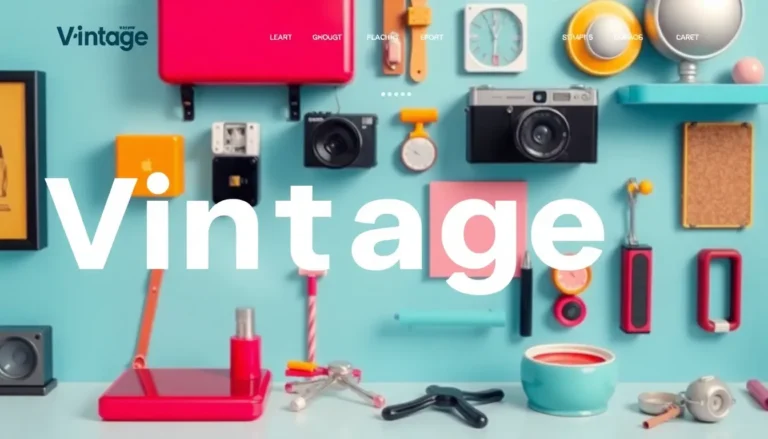In a world where attention spans rival that of goldfish, infinite scroll implementation has emerged as the superhero of user experience. It swoops in to save users from the dreaded “next page” button, offering a seamless journey through content that keeps them engaged and scrolling. Who wouldn’t want to dive into an endless ocean of information without the pesky interruptions?
Table of Contents
ToggleOverview of Infinite Scroll Implementation
Infinite scroll implementation serves as a modern solution for displaying large datasets. This technique allows web pages to load content continuously as users scroll down, rather than requiring manual clicks on pagination buttons. Enhanced engagement results from this design, catering to users’ preference for instant gratification in content consumption.
Websites utilizing infinite scroll include social media platforms and e-commerce sites. These examples illustrate how infinite scroll captures user attention and encourages prolonged interaction. Users find an endless stream of images or products, promoting exploration and engagement.
Performance optimization matters in implementing infinite scroll. Developers must ensure efficient loading of data to avoid long wait times or lag. Techniques such as lazy loading help in managing loading times, resulting in a smoother user experience.
Accessibility considerations arise when designing for infinite scroll. Developers should incorporate proper loading indicators and allow for keyboard navigation. Ensuring users can access content without frustration leads to a more inclusive experience.
Testing plays a crucial role in refining infinite scroll implementations. A/B testing helps in gathering user feedback and understanding scrolling behaviors. This data can inform design choices, making the experience more intuitive.
Overall, infinite scroll implementation provides a dynamic approach to content delivery. It transforms how users interact with web pages and enhances the overall browsing experience. Prioritizing user satisfaction through seamless design choices continues to shape web development trends.
Benefits of Infinite Scroll
Infinite scroll significantly enhances user interaction and promotes a more dynamic browsing experience. This method encourages users to engage with more content without the interruption of pagination.
Improved User Engagement
Users often find continuous scrolling more enjoyable compared to clicking through pages. Engagement levels increase as visitors stay on the site longer, captivated by the seamless flow of content. Websites that utilize infinite scrolling frequently observe higher click-through rates on links and more page views per session. Social media platforms effectively harness this technique, keeping users immersed in endless feeds of content, leading to increased interaction and sharing. Consequently, platforms report higher retention rates, demonstrating the positive impact of this design choice on user behavior.
Increased Content Discovery
Content discovery benefits significantly from infinite scroll. Users can explore a diverse range of items without facing barriers that traditional pagination imposes. As a result, consumers are more likely to stumble upon products or posts they might otherwise overlook. E-commerce sites often employ this strategy, showcasing more inventory seamlessly. Enhanced visibility of various items can lead to higher conversion rates as users encounter a wider selection. Data indicates that facilitated browsing translates to increased engagement, ultimately boosting sales and creating a more satisfying shopping experience.
Challenges of Infinite Scroll Implementation
Infinite scroll offers advantages, but it also presents challenges that developers face during implementation. Below are two major concerns.
Performance Issues
Performance issues can arise with infinite scroll as large datasets may lead to increased loading times. Users experience delays when content loads slowly, diminishing their overall experience. Data fetching methods contribute to this concern, especially if server requests become numerous. Developers might implement lazy loading techniques for optimizing performance, yet testing these methods remains crucial. Continuous monitoring helps identify bottlenecks and ensures smooth interactions as users scroll.
Accessibility Concerns
Accessibility concerns surface with infinite scroll, affecting users who rely on assistive technologies. Screen readers may struggle to navigate dynamically loaded content, resulting in potential usability challenges. Proper loading indicators serve to inform users of new content availability. Keyboard navigation improvements enhance the experience for those unable to use a mouse. Continuous engagement with accessibility standards ensures inclusiveness in design, allowing all users to benefit from the streamlined interface.
Best Practices for Implementing Infinite Scroll
Effective infinite scroll implementation enhances user engagement. Adhering to best practices ensures seamless browsing experiences.
Loading Indicators
Loading indicators provide users with clear feedback. They’re essential for signaling when new content is loading. A spinner or progress bar can signal ongoing processes, preventing confusion during waits. Including visible indicators enhances user experience by fostering patience. Examples of effective loading indicators can be seen on many popular platforms, where users remain informed about content retrieval. Proper user experience design incorporates these indicators in a way that feels natural and unobtrusive.
Pagination Alternatives
Offering pagination alternatives complements infinite scroll technology. End-of-page links or buttons allow users to jump to specific sections. Users may find these alternatives helpful, especially when seeking content quickly. Providing a comprehensive overview, like a table of contents or categorized sections, can assist users navigating extensive datasets. It balances the continuous flow of infinite scroll with the convenience of targeted access. Such methods maintain engagement while ensuring accessibility to desired information.
Conclusion
Infinite scroll implementation represents a significant shift in how users interact with content online. By providing a seamless experience that caters to shorter attention spans it keeps users engaged and encourages exploration. The technique’s ability to enhance visibility and drive conversions makes it particularly valuable for e-commerce and social media platforms.
However developers must remain vigilant about performance and accessibility challenges. By employing strategies like lazy loading and incorporating effective loading indicators they can create a smooth experience for all users. Balancing infinite scroll with thoughtful navigation alternatives ensures that users can find what they need without frustration. Embracing these best practices will ultimately lead to a more dynamic and satisfying browsing experience.




